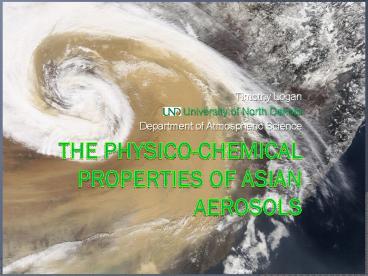The physico-chemical properties of Asian aerosols - PowerPoint PPT Presentation
1 / 13
Title:
The physico-chemical properties of Asian aerosols
Description:
Timothy Logan University of North Dakota Department of Atmospheric Science Outline Aerosol Characteristics Formation and Behavior Aerosol Detection and Transport ... – PowerPoint PPT presentation
Number of Views:71
Avg rating:3.0/5.0
Title: The physico-chemical properties of Asian aerosols
1
The physico-chemical properties of Asian aerosols
- Timothy Logan
- University of North Dakota
- Department of Atmospheric Science
2
Outline
- Aerosol Characteristics
- Formation and Behavior
- Aerosol Detection and Transport
- Asian aerosol events
- Past research findings
- Aerosol Classification
- Current research
- Seasonal variability
- Research Applications
- Primary tools and methods
- Main goals and applications
3
Aerosol Characteristics
Anthropogenic Aerosols
Natural Aerosols
http//www.sciencenews.org/view/feature/id/65734/t
itle/The_final_climate_frontiers
NASA Terra Image 20 Mar 2011
4
Aerosol Detection
- Size and composition of aerosols
- Attenuation of EM radiation illustrates the
nature of aerosols - Aerosol optical depth (AOD)
- Aerosol attenuation (extinction) is the sum of
the aerosol scattering and absorption of light - Extinction part correlated with size
- Absorption part correlated with composition
- Recent studies looking into this
- Main focus of current research
5
Aerosol Detection
- My past research
- Used dependence of extinction AOD over a
wavelength interval (Angstrom exponent or a) - Distinguishes between small and large aerosols
- Fine mode vs. coarse mode aerosols
- Does not distinguish aerosol composition
- Some pollution aerosols can disguise themselves
as large size natural aerosols - Detected Asian aerosol events capable of
transporting large amounts of dust and pollution
via the Pacific Ocean to North America - Primarily used aerosol size as a proxy
6
Aerosol Transport
Aerosol Optical Depth Frequency of Occurrence
Aerosol Transport Trend
MODIS AOD Retrievals
AOD gt 0.2
AOD gt 0.4
AOD gt 0.6
Major Aerosol Regions
7
Aerosol Classification
- Current research uses second derivative of the
absorption part of AOD - Spectral curvature or daabs (slope of aabs)
- Develop a classification scheme that reduces
ambiguities in Asian aerosol composition - Preliminary results show a clustering of
different types of aerosols - Sulfate, biomass, mineral dust, black carbon
- Can also see a seasonal variability and rate of
change of Asian aerosol composition
8
2008 AERONET Derived Aerosol Seasonal Variability
Xianghe, China 39N 117E
Desert Regions
- Discussion (Absorption)
- Most mean aabs values for the two seasons fall
between 1 and 2 (red lines) - Mean daabs (blue line) explains seasonal
variance - Summer mean daabs is slightly negative
- Sulfate and/or other scattering aerosols
- Winter mean daabs is much higher
- Indicating strong absorption
- Result of coal and wood combustion for heat
Urban Region
Clean Region
9
Research Applications
- My research both past and present relies heavily
on in situ AERONET, aircraft, space based, and
re-analysis observations. - NASA sponsored/maintained platforms
- Main goal of research is to classify aerosols and
the variability of their compositions as they
transport far away from their source regions - Determine their effects on climate change and
human health
10
Thank You
11
Extra Slides
12
Aerosol Characteristics
- Aerosol formation
- Classified as either man-made (anthropogenic) or
natural - Aerosol behavior
- In terms of climate change direct vs. indirect
effect - Influence solar radiation vs. cloud physical
properties - Effects are influenced by physical and chemical
properties of aerosols - Radiative properties, size and chemical structure
13
(No Transcript)

